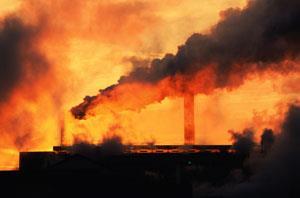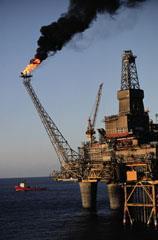Carbon dioxide levels in the atmosphere are higher today than they have been at any time in the past 150,000 years. With strong evidence linking CO2 emissions to global warming and climate change, chemists are looking for ways to capture this greenhouse gas, and store it or use it

Since the start of the industrial revolution, around 200 years ago, scientists estimate there has been a 30 per cent increase in carbon dioxide concentrations in the atmosphere, and with Man's unquenchable thirst for energy - in the form of heat, electricity and transport fuel - this figure is set to rise (see Box for UK 2005 CO2 data).
In computer-based models, rising concentrations of greenhouse gases point to an increase in the average temperature of the Earth. Such temperature rises, most scientists now agree, contribute to change in weather, sea levels, and land use. Melting ice caps, reduced crop yields, droughts and flooding, forest fires and coral bleaching are commonly cited consequences of global warming. The UK Government acknowledges this concern and has recently set a UK carbon reduction goal of 60 per cent by 2050. The development of existing carbon capture and storage (CCS) technology on a large-scale in energy- and cost-effective ways by chemical scientists and engineers is expected to play a major part in meeting this target.
Capture technologies
There are essentially three existing routes to CO2 capture that scientists are examining.
- Pre-combustion capture. Prior to combustion, the fuel (coal, natural gas or biomass) is partially oxidised to a mixture of CO and H2. The CO/H2 mixture is then used as fuel, which on burning gives a high pressure stream of CO2 and H2O. These gases can be separated by using physical absorption methods such as membranes or cryogenic (low temperature) systems. A range of ceramic membranes is being considered, which have exact pore sizes for allowing specific gases through. In the cryogenic process the gases are first frozen and then, as the temperature is allowed to rise, gases are isolated according to their freezing points. BP is currently investigating pre-combustion capture at its Peterhead Power Station in Scotland. The idea is that CO2 generated will be exported to the Miller oil field in the North Sea to displace and recover more oil from this field. The project, if financially backed by Government, could start operation in 2009. BP scientists estimate that this technology, costing around £300 m, will capture and ultimately store around 1.3 million tonnes of CO2 per year, representing a reduction in CO2 emissions from the plant to the atmosphere of 90 per cent.
- Post-combustion capture. Here low-pressure CO2 is isolated from flue gas (which also contains N2 and O2) after combustion by using solvent 'scrubbing systems'. Carbon dioxide is brought into contact with a solvent such as monoethanolamine: the amine selectively absorbs CO2 by reacting with it to form a loosely bound compound. This is then pumped into another tower where the pressure is reduced or the temperature increased to release the CO2. Such systems could be used in coal-fired power stations, cement kilns and industrial boilers and furnaces, recovering up to 98 per cent of the CO2 with a purity of 99+ per cent. Current research is focusing on using different solvent systems to bring down the costs of this technology.
- Oxyfuel combustion. The fuel is burnt in pure oxygen, so N2 is first separated from O2 by using a cryogenic method, which gives liquid O2 and gaseous N2. The resulting flue gas contains mainly CO2 and water. Water can be condensed from the flue gas and CO2 is compressed ready for transportation. This technology has already been applied in some glass, steel and iron industries but has yet to be applied widely because oxygen separation is energy-intensive and very expensive.
Some scientists are investigating the possibility of capturing CO2 directly from the atmosphere by using tall convection towers (300 m high × 115 m diameter), where a down draft is created by cold water being pumped to the top. According to the researchers, air flowing out of the bottom of the tower would pass some 9500 tonnes of CO2 per day through a Ca(OH)2 absorbent. The latter would be regenerated to release a stream of CO2 for disposal. The researchers estimate that all the CO2 produced by road transport could be captured for the equivalent of around 10p per gallon of petrol used.
Carbon storage
Several sites are currently being considered for CO2 storage. These include:
- underground depleted oil and gas fields;
- deep saline aquifers - these are natural channels of porous rocks between geological formations under the sea;
- unmineable coal seams.
The CO2 storage capacity of old and current oil and gas fields in Western Europe amounts to ca 37 billion tonnes, which is only a few per cent of the estimated storage capacity of saline aquifers. However, oil field storage offers the potential of recovering more oil, which is a big incentive for oil companies to invest in this option. There are around 70 planned and on-going demonstration projects worldwide for CO2 storage in oil fields and aquifers.
Deep ocean storage is also being considered, mainly in the US. One option here involves pumping CO2 into the ocean at depths below 3000 m, where the now liquid CO2 would be denser than water under these pressures. However, much work needs to be done into the behaviour of CO2 under these extreme conditions and what effects such a lake of CO2 is likely to have on the unique plant and animal life in this region. Another factor to consider is the stability of the CO2 pool in the event of a sub-sea earthquake. An up-welling of CO2 gas could cause a massive eruption of CO2 gas at the ocean surface.
Using CO2

As well as enhanced oil recovery, other potential uses of captured CO2 will be in the food and drinks industry, and in the manufacture of a host of organic chemicals. Chemists across the world are looking at ways to reduce CO2 into useful hydrocarbons, and to mimic natural photosynthesis as a way of converting CO2 into carbohydrates.
Whether the potential of CCS is realised will come down to costs and what financial penalties are put on industry and transport for producing CO2. Carbon capture and storage requires energy, which would increase the use of fossil fuels. An intergovernment panel on climate change estimates that the cost of implementing CCS technology would increase the energy requirements of power plants by 10-40 per cent, which would put the cost of energy from such plants up by 30-60 per cent. But perhaps a more important question should be: 'What will be the long-term costs to our planet if CO2 emissions are not reduced'?
Acknowledgements
My thanks to Dr Jeff Hardy, energy expert at the RSC, for his comments on this article.
UK carbon dioxide emissions
The following are the UK Department of Trade and Industry's (DTI) figures for CO2 emissions for 2005, in million tonnes:
- power stations (gas and coal), 47.1;
- oil refineries (manufacturing chemicals and fuel), 5.6;
- residential (cooking, space heating, lights and appliances, and water heating), 22.3;
- services (eg waste disposal), 6.8;
- road transport, 33.3;
- other transport uses (including air transport), 3.8;
- industry (cement manufacture, ethene production, pharmaceuticals, ammonia/fertiliser manufacture, natural gas processing, hydrogen production and the aluminium, iron and steel industries), 31.4.
The total carbon dioxide emissions for the UK in 2005 was 150.3 million tonnes.
In contrast, you might be interested to know that the average take-off weight of a Boeing 747 'Jumbo' aircraft is ca 300 tonnes, and that an ocean-going super tanker weighs approximately 250,000 tonnes.






No comments yet